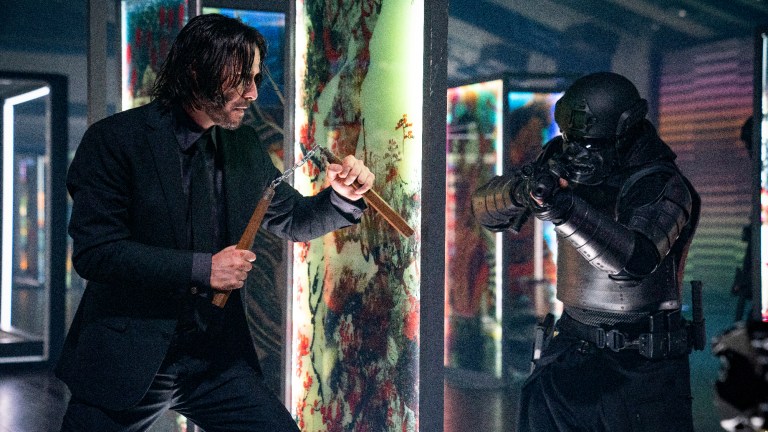John Wick: Chapter 4 Review: Better Than Ever with Keanu Reeves vs. Donnie Yen
Four movies in, John Wick star Keanu Reeves and director Chad Stahelski are still finding ways to surprise us.

I’ve had a sort of Star Trek thing going on with the John Wick franchise: the odd-numbered films have never fully impressed us, while the even-numbered John Wick: Chapter 2 was a dazzling tour de force that elevated the series to a whole new level of action filmmaking. So I’m happy to report that the odd-even rule continues to be in effect. John Wick: Chapter 4 is a frequently astonishing epic that moves the story forward from the relative wheel-spinning of Chapter 3, using its whopping two-hour-and-49-minute runtime to deliver more stunning action, a heavier dose of humor, and even some moments of reflection and character development that may make the pace flag a little but ultimately provide satisfaction.
The film, once again directed by Chad Stahelski and of course starring Keanu Reeves as the title assassin/avenging angel of death, also brings John’s story to a possible conclusion of sorts, although there’s just enough ambiguity to the proceedings to leave the door open for further adventures. But first, there’s the story at hand to get through, which opens with the bounty on John’s head continuing to rise as the High Table—the sort of Illuminati of crime organizations around the world—still wants our hero dead for breaking its rules and doing his best to wrest his freedom from their reign.
John, however, has just about had enough. After a brief opening training session and the delivery of a new suit by returning underground crime lord The Bowery King (Laurence Fishburne), John takes the fight to the High Table in shocking fashion, launching a chain of events that not only keeps him squarely in the sights of that still-unseen governing body but also has dangerous repercussions for New York Continental manager Winston (Ian McShane) and his loyal concierge Charon (Lance Reddick).
The High Table’s latest counter-attack against John and his dwindling roster of allies is spearheaded by the Marquis de Gramont (Bill Skarsgård, channeling some of the mirthful, dead-eyed malevolence that made him so effective as Pennywise in It), who has a vast wealth and armies of killers at his disposal, yet still sends two more deadly adversaries in search of John. One is a fringe assassin known only as The Tracker (Shamier Anderson), whose old-school tactics and canine companion belie a laser-like focus on claiming the bounty, while the other is Caine (Donnie Yen), an old friend of John’s who’s been forced back into the High Table’s employ via threats to his daughter.
Once the game is fully afoot, the film takes John from New York City—where most of the saga has been thus far set—to locales such as Jordan, Berlin, Osaka, and Paris, the latter of which features three jaw-dropping fight/chase sequences that are as captivating for their humor as their stylized choreography. Through it all remains Stahelski’s ability to map out the action in fresh new ways.
Also joining the festivities this time are legendary Japanese actor/martial arts master Hiroyuki Sanada as Shimazu, manager of the Osaka Continental and another old friend of John’s, Rina Sawayama as Akira, Shimazu’s daughter and concierge, and an unrecognizable Scott Adkins as Killa, a massive, grotesque German gangster who, naturally, has a bone to pick with John as well. Clancy Brown (The Shawshank Redemption) also appears as the Harbinger, who represents the High Table and gives orders that take the story through some surprising turns.
While all the cast acquit themselves well—McShane is dependably cynical, Skarsgård is deliciously evil, Brown is sinister and magisterial, and Adkins definitively steals his entire section of the movie—the standout out is Donnie Yen. Although it’s a little jarring to see Yen once again play a blind warrior-type after his high-profile turn in Rogue One: A Star Wars Story seven (!) years ago, Caine is one of the more fascinating creations in the John Wick character roster.
World-weary, reluctant to spring into action, but possessed of effortless poise and grace, Caine is clearly conflicted by his assignment and projects a deep sadness over the turn his life has taken as well as a fierce devotion to protecting those he loves. Yen is sensational, imbuing Caine with a subtle depth that recalls Tony Leung’s underrated work as Xu Wenwu in Shang-Chi and the Legend of the Ten Rings.
In addition to his impeccable physical skills, Yen brings a gravitas to his role that is matched by fellow vet Sanada, whose own long, distinguished career has brought him to a place where his mere presence is a bonus. As for their leading man, even after his own long career, Reeves may not have quite the range and depth of these legendary actors, but there’s a sense here that he’s always working on upping his game, and the script gives him plenty of moments to do just that.
As we mentioned, John Wick: Chapter 4 is easily the lengthiest film in the series, and that extra space both acts as a hindrance and an opportunity: The former because it does tend to slow the pace of what has been a reliably fast-moving saga, and the latter because it gives the characters and filmmakers (and us) a chance to pause, catch a few breaths, and add more texture to an already strangely rich universe.
But the three most appealing elements (besides the cast) of the John Wick franchise are all present and accounted for: the surreal nature of the world of John, the Continental, and the High Table, a reality that exists hidden in the shadows of ours and never explains itself too much; the sly humor that permeates the film, letting us know that the filmmakers are self-aware of how far they push this heightened reality; and the action/fight scenes that are the series’ trademark, which also push the boundaries of reality while dazzling us with their structure, composition, and geography.
It’s true that John, his allies, and his enemies are operating just one level below that of superheroes these days (he’s been wearing Kevlar suits since the second film), and that it takes a lot to keep them down, which is best represented in a genuinely hilarious scene that finds John doggedly trying to climb hundreds of steps to reach a plaza—only to be sent tumbling down. That scene, along with a gripping set piece at the Arc de Triomphe traffic circle in Paris during which a staggering amount of fighters weave in, out, over, and under a relentless onslaught of oncoming vehicles, has a decidedly over-the-top tone that incorporates aspects of Tex Avery and Sam Raimi (play a little game during the traffic circle sequence and count just how many times John collides with a car).
On the other hand, another scene in which Stahelski takes a bird’s-eye view of a labyrinthine Paris apartment as John and his enemies battle their way through that—complete with a weapon that fires incendiary bullets—is breathtaking in its expertly staged anarchy.
It’s moments like these, plus the highly stylized sets, costumes, and performances, that keep the John Wick franchise alive and fresh, and with this chapter, Stahelski, Reeves, and company have not only earned the right to stretch things out a bit, but they give the story a natural and almost intimate climax. How you interpret that ending and where things go from here will remain, like John himself and his reality-adjacent world, an enigma for now, although you should stay all the way through the end credits for one possible hint.
John Wick: Chapter 4 opens in theaters on March 24.
